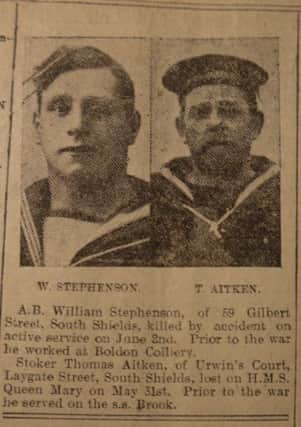South Tyneside's Jutland heroes


In the light of this, I asked readers to let me know of any local men who fought in the battle. As a result, Peter Hoy got in touch to tell me about nine local men who died in the conflict.
Peter said details of the losses were detailed in the May edition of South Shields’ Local History Group’s newsletter. Today, he shares those details with Time Of Our Lives.
Advertisement
Hide AdAdvertisement
Hide AdPeter said: “Nine South Tyneside men were among the 6,097 Royal Navy sailors who died during the Battle of Jutland, the greatest naval battle of all time – between the British Grand Fleet and the Imperial German Navy.
“Total British losses amounted to a displacement of 113,000 tons or 14 vessels; total German losses were 61,000 tons or 11 vessels.”
Peter explains that British losses included the dreadnought battlecruisers Indefatigable, Invincible and Queen Mary, and the armoured cruisers Black Prince, Defence and Warrior.
“The Germans lost one battlecruiser, SMS Lützow, and 2,551 men killed.”
Advertisement
Hide AdAdvertisement
Hide AdThe nine men who died were: Stoker Thomas Aitken, HMS Queen Mary (The Battlecruiser Fleet/1st Battlecruiser Squadron) (1612U), May 31, 1916, aged 44 (Born: June 9, 1872 – RN Service Record). Chatham Naval Memorial.
Stoker (First Class) George Buckham, HMS Queen Mary (The Battlecruiser Fleet/1st Battlecruiser Squadron) (K/17649), May 31, 1916, aged 22 (Born: February 5, 1894 RN Service Record). Portsmouth Naval Memorial.
Able Seaman James Henry Buglass, HMS Queen Mary (The Battlecruiser Fleet/1st Battlecruiser Squadron) (TZ/6786), May 31, 1916, aged 22 (Born: September 2, 1893 – RN Service Record). Chatham Naval Memorial.
Engine Room Artificer Peter Callender, HMS Invincible (3rd Battlecruiser Squadron) (M/15248), May 31, 1916, aged 25 (Born: December 2, 1889 – RN Service Record). Chatham Naval Memorial.
Advertisement
Hide AdAdvertisement
Hide AdStoker Robert Graves, HMS Queen Mary (The Battlecruiser Fleet/1st Battlecruiser Squadron) (2973T Royal Naval Reserve), May 31, 1916, aged 34. Chatham Naval Memorial.
Stoker William Foster Gunn, HMS Defence (1st Cruiser Squadron (Armoured Cruisers)) (3793 Royal Naval Reserve), May 31, 1916, aged 25. Chatham Naval Memorial.
Signalman Richard Henry (Harry) Lock, HMS Indefatigable (The Battlecruiser Fleet/2nd Battlecruiser Squadron) (TZ/372 Royal Naval Voluntary Reserve), May 31, 1916, aged 21. Chatham Naval Memorial.
Engine Room Artificer John Sandilands, HMS Defence (1st Cruiser Squadron (Armoured Cruisers)) (M/4276), May 31, 1916, aged 36. Plymouth Naval Memorial.
Advertisement
Hide AdAdvertisement
Hide AdStoker William Waugh Smith, HMS Indefatigable (The Battlecruiser Fleet/2nd Battlecruiser Squadron) (4046S), May 31, 1916, aged 27. Chatham Naval Memorial.
“Three of these men were stokers aboard HMS Queen Mary and a fourth man served as an able seaman,” continues Peter.
“They were among the 1,266 men who died when the ship sank – there were only 20 survivors.”
“The Queen Mary was a Lion Class battlecruiser, 700 feet in length, having a beam of 88 feet, displacing 26,350 tons, and it was powered by four Parsons’ turbines which furnished 70,000 ship’s horse-power, enabling a top speed of 27 knots per hour. Its main armament comprised eight 13.5-inch guns and 16 four-inch guns.
Advertisement
Hide AdAdvertisement
Hide Ad“It was laid down at Palmer’s in March 1911 and cost £2,078,491 to build.
“At first the Queen Mary acquitted herself well, hitting SMS Seydlitz four times with her 13.5-inch shells. However, at 4.21 pm. her Q turret was hit twice in quick succession, causing a massive explosion that effectively broke the ship in half, lifting the bow section clean out of the water.
“Within seconds all that was visible was the stern, with repeated explosions tearing parts of the ship to pieces.
“It was the sinking of HMS Queen Mary which occasioned the following famous response from Sir David Beatty, Commanding Officer of the Battle Cruiser Force: ‘There seems to be something wrong with our bloody ships today!’
Advertisement
Hide AdAdvertisement
Hide Ad“It is probably fair to view the outcome of Jutland as a tactical victory for the Germans, but a strategic victory for the British.
“After Jutland, the much-vaunted German High Seas Fleet was not to put to sea again until it headed for Scapa Flow in November 1918 to ignominious surrender and internment.
“As one astute New York journalist observed: ‘The German Fleet has assaulted its jailer, but it is still in jail.’”
“On November 21, 1918, what remained of the German High Seas Fleet, consisting of nine battleships, five battlecruisers, seven light cruisers and 49 torpedo boats left their bases for the last time.
Advertisement
Hide AdAdvertisement
Hide Ad“Crewed by a minimum number of men, they rendezvoused with the entire Grand Fleet, a French cruiser and an American battle squadron off the coast of Scotland. “
As Peter goes on to say: “Beatty signalled to the German ships: ‘The German flag will be hauled down at sunset today and will not be hoisted again without permission.’
“After languishing at anchor for six months at Scapa Flow, on June 21, 1919, the Germans deliberately scuttled every single ship.
“Rear Admiral Ludwig von Reuter ordered that all ships’ seacocks, doors, tubes and drains were to be opened and, slowly, all 74 vessels of the German fleet began to sink forever.
Advertisement
Hide AdAdvertisement
Hide Ad“ The Kaiser’s navy, his pride and joy, which had dared to challenge the British naval supremacy that had lasted since Trafalgar, now lay deep in the waters of Scapa Flow, having emitted barely a whimper.”
l Next week: Peter provides us with more details of the heroic men who gave their life in service of their country. Also fascinating memories of Mr William Henry Cunningham, who fought in the Battle of Jutland as well as in the evacuation of Dunkirk.